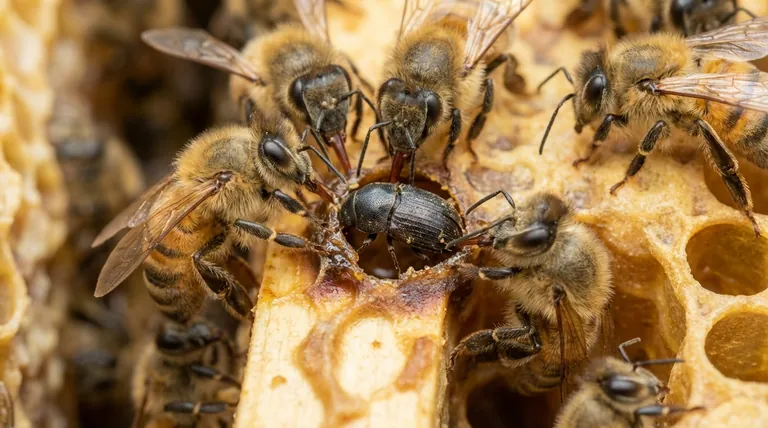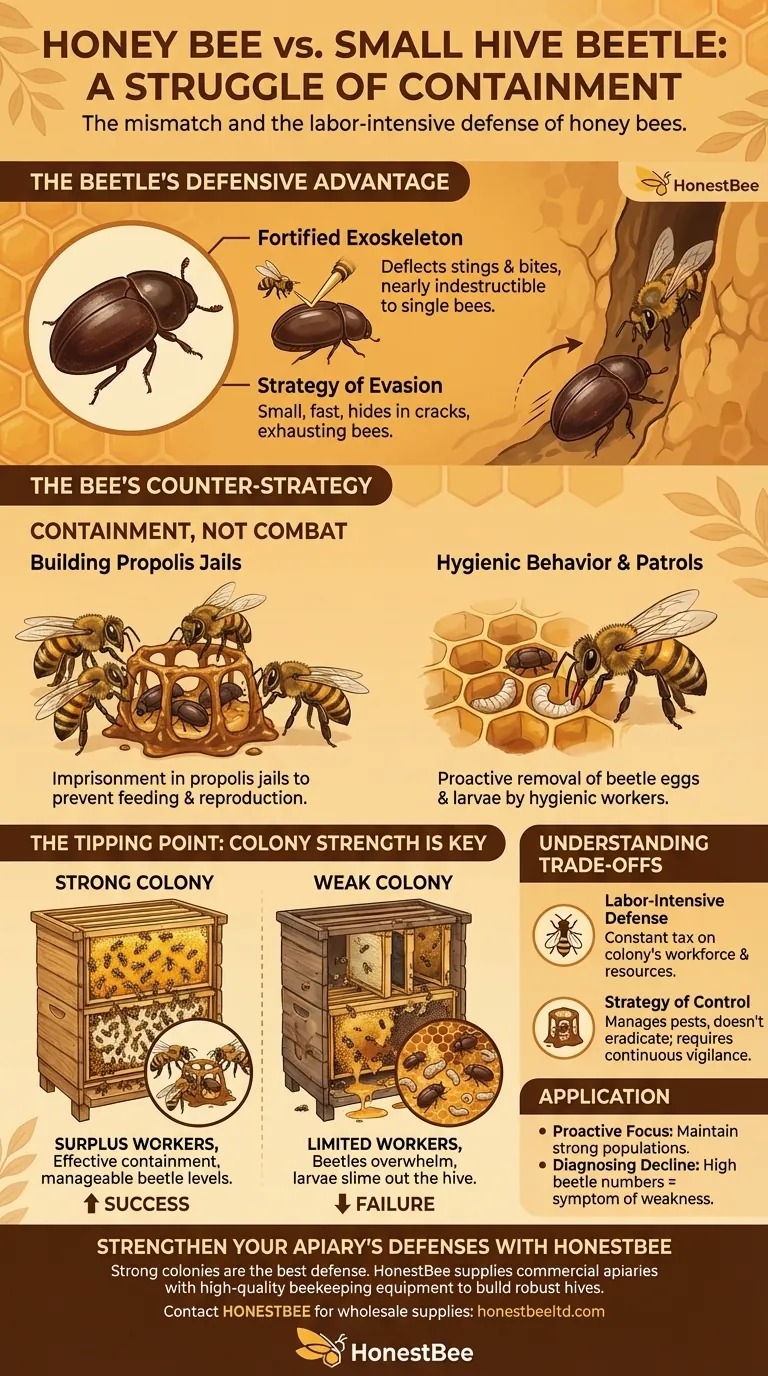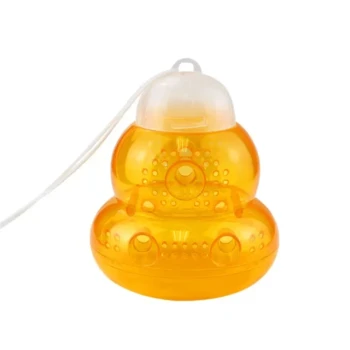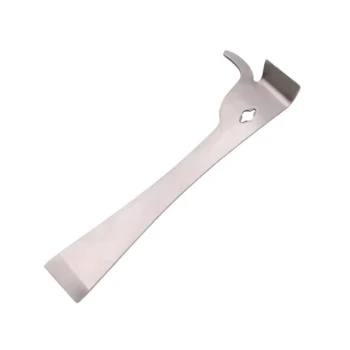At its core, the struggle between honey bees and the small hive beetle is a story of physical mismatch. Honey bees are ill-equipped to kill the beetles directly because the invaders possess a hard, durable exoskeleton, are small and fast, and have a defensive behavior of hiding in the hive's crevices. This forces the bees into a strategy of containment rather than direct combat.
The central issue is not that bees fail to kill small hive beetles, but that their primary defense—imprisoning them in propolis jails—is a labor-intensive strategy. A colony's success or failure against this pest is a direct reflection of its overall strength and ability to sustain this continuous containment effort.

The Beetle's Defensive Advantage
The small hive beetle (Aethina tumida) is perfectly adapted to survive inside a honey bee colony. Its physical and behavioral traits are not accidental; they are the keys to its success as an invasive pest.
A Fortified Exoskeleton
The beetle's hard, smooth shell is its primary defense. It is highly effective at deflecting bee stings and bites, making it nearly impossible for a single bee or even a small group to inflict lethal damage.
A Strategy of Evasion
Small hive beetles are significantly smaller and faster than honey bees. When confronted, they quickly run and tuck themselves into the hive's cracks and empty cells. This constant evasion exhausts the bees and makes capture difficult.
The Bee's Counter-Strategy: Containment, Not Combat
Because killing the beetles is inefficient, honey bees have developed a sophisticated management strategy. Their goal is not eradication but control through constant vigilance and social organization.
Building Propolis Jails
The bees' most effective defense is imprisonment. Guard bees work to corral and confine beetles into small "jails" constructed from propolis, a sticky resin collected from plants.
Once trapped, the beetles are unable to feed or lay eggs. A few guard bees will stand watch over these confinement sites, ensuring the pests remain contained.
Hygienic Behavior and Patrols
Some honey bee colonies exhibit strong hygienic behavior. Worker bees will actively patrol the comb, seeking out and removing beetle eggs and larvae before they can mature and cause damage. This proactive cleaning is a critical secondary defense.
The Tipping Point: Why Colony Strength is Everything
The balance of power between bees and beetles hinges on one factor: colony strength. The outcome of the infestation is almost always predetermined by the hive's population size and overall health.
The Power of a Strong Colony
A strong, populous colony has a surplus of worker bees. It can afford to allocate a dedicated workforce to corralling beetles into propolis jails without neglecting essential tasks like foraging, nursing brood, and defending the entrance.
With enough bees, the beetles are quickly contained, and their numbers are kept at a manageable, non-threatening level.
How Weak Colonies Become Overwhelmed
In a weak or dwindling colony, every bee is essential for core survival tasks. There are simply not enough surplus bees to effectively manage a growing beetle population.
As the beetles are left unchecked, they begin to reproduce. Their larvae burrow through the comb, consuming honey, pollen, and bee brood, which ultimately causes the honey to ferment and foul the hive in an event known as a "slime out."
Understanding the Trade-offs
The bees' containment strategy, while ingenious, comes with significant costs. Recognizing these limitations is crucial to understanding why even strong colonies can sometimes feel the pressure.
A Labor-Intensive Defense
Containing beetles is a continuous, resource-intensive job. Every bee assigned to guard duty is a bee that is not foraging for nectar or caring for the next generation. A persistent beetle presence acts as a constant tax on the colony's workforce.
A Strategy of Control, Not Eradication
Imprisonment only works as long as the colony can maintain it. It does not eliminate the beetles from the hive, but merely manages them. Any event that weakens the colony—such as disease, a poor nectar flow, or a queen issue—can allow the contained beetle population to break out and quickly overwhelm their captors.
How to Apply This to Your Hive
Understanding this dynamic allows you to shift from seeing beetles as an attack to seeing them as an indicator of hive health.
- If your primary focus is proactive beetle management: Success depends on maintaining strong, populous colonies above all else. A large bee population is the single most effective tool against small hive beetles.
- If you are diagnosing a hive in decline: A high beetle count is often a symptom of an underlying problem, not the root cause. Investigate queen health, mite loads, and food stores to address the core weakness that allowed the beetles to gain an advantage.
Ultimately, supporting your bees' natural defenses by promoting colony strength is the most powerful way to control the small hive beetle.
Summary Table:
| Key Factor | Description | Impact on Bees |
|---|---|---|
| Beetle's Exoskeleton | Hard, smooth shell | Deflects bee stings and bites |
| Beetle's Evasion | Small, fast, hides in crevices | Exhausts bees, makes capture difficult |
| Bee's Strategy | Containment in propolis jails | Labor-intensive, requires strong colony |
| Colony Strength | Large, healthy bee population | Determines success or failure of containment |
Strengthen Your Apiary's Defenses with HONESTBEE
Is the small hive beetle a persistent challenge in your operation? A strong, well-equipped colony is the best defense. HONESTBEE supplies commercial apiaries and beekeeping equipment distributors with the high-quality supplies and equipment needed to build and maintain robust, healthy hives.
We understand the demands of large-scale beekeeping. Let us help you ensure your colonies have the population strength to effectively manage pests.
Contact HONESTBEE today to discuss wholesale supplies for your commercial beekeeping needs.
Visual Guide

Related Products
- Reusable Clear Small Hive Beetle Traps for Beehives Beetle Trapping Tools
- Removable Washable Hive Beetle Trap Attractants for Small Hive Beetles
- Black Plastic Beetle Barn Hive Beetle Trap for Beehives
- Reusable Aluminium Beetle Trap for Small Hive Beetles Silver Bullet
- Plastic Beetle Blaster Trap Beekeeping Tools and Supplies
People Also Ask
- What are small hive beetles and where are they not indigenous? Protect Your Apiary from This Invasive Pest
- Why are hive beetle traps important for beekeepers? Protect Your Hive from a Devastating Infestation
- How do Beetle Blasters trap adult beetles? A Simple, Non-Chemical Pest Control Solution
- How should filled beetle traps be handled? Safely Remove and Dispose to Protect Your Hive
- What are the steps for installing hive beetle traps? A Guide to Effective Beetle Control



















